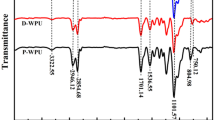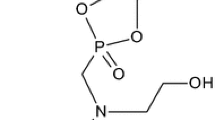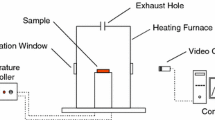Abstract
A novel hydrophilic curing agent was prepared through hexamethylene diisocyanate trimer, polyethylene glycol monomethyl ether, and 2-((2-aminoethyl)amino)-ethanesulfonic acid monosodium salt. Then, flame-retardant two-component waterborne polyurethanes and their coatings were synthesized through adding the novel hydrophilic curing agent. Their properties and analysis were characterized through fourier-transformed infrared spectroscopy, differential scanning calorimeter, thermogravimetric, thermogravimetric infrared, limiting oxygen index, and UL-94. As a result, the −NCO content of novel hydrophilic curing agent was 16.4% and above 10.0% about 4 months. Besides, the novel hydrophilic curing agent dispersed well in two-component emulsions and improved themostability and compatibility of two-component flame-retardant waterborne polyurethanes. Meanwhile, the tensile strength of the novel film was 1.5 times than the previous one through adding novel hydrophilic curing agent at the same stoichiometric ratio of −NCO to −OH. What’s more, the best LOI and UL-94 of modified flame-retardant two-component waterborne polyurethane were 29.2% and V-0, respectively.






Similar content being viewed by others
References
Akbarian M, Olya ME, Ataeefard M, Mahdavian M (2012) The influence of nanosilver on thermal and antibacterial properties of a 2K waterborne polyurethane coating. Progress in Organic Coatings 75(4):344–348. https://doi.org/10.1016/j.porgcoat.2012.07.017
Ge Z, Luo Y (2013) Synthesis and characterization of siloxane-modified two-component waterborne polyurethane. Progress in Organic Coatings 76(11):1522–1526. https://doi.org/10.1016/j.porgcoat.2013.06.007
Wu G, Li J, Chai C, Ge Z, Lin J, Luo Y (2015) Synthesis and characterization of novel post-chain extension flame retardant waterborne polyurethane. RSC Adv 5(118):97710–97719. https://doi.org/10.1039/c5ra12975c
Alcón MJ, Ribera G, Galià M, Cádiz V (2005) Advanced flame-retardant epoxy resins from phosphorus-containing diol. J Polym Sci A Polym Chem 43(16):3510–3515. https://doi.org/10.1002/pola.20856
Geurink PJA, Scherer T, Buter R, Steenbergen A, Henderiks H (2006) A complete new design for waterborne 2-pack PUR coatings with robust application properties. Prog Org Coat 55(2):119–127. https://doi.org/10.1016/j.porgcoat.2005.08.014
Jacobs Patricia B. PTA (1992) Water dispersible polyisocyanates. CA2088311A1
Karl H (1994) Water-emulsifiable polyisocyanates. CA2158621A1,
Luo Y, Yin X, Chai C, Ge Z (2017) A kind of mixed hydrophilic polyisocyanate curing agent and its preparation method
Yin X, Luo Y, Zhang J (2017) Synthesis and characterization of halogen-free flame retardant two-component waterborne polyurethane by different modification. Ind Eng Chem Res 56(7):1791–1802. https://doi.org/10.1021/acs.iecr.6b04452
Birowosuto MD, Takiguchi M, Olivier A, Tobing LY, Kuramochi E, Yokoo A, Hong W, Notomi M (2017) Temperature-dependent spontaneous emission of PbS quantum dots inside photonic nanostructures at telecommunication wavelength. Opt Commun 383:555–560. https://doi.org/10.1016/j.optcom.2016.09.059
Wu Guomin KZ, Caifeng C, Jian C, Shuping H, Jianchun J (2013) Crosslinking reaction and properties of two-component waterborne polyurethane from terpene-maleic ester type epoxy resin. J Appl Polym Sci 128:132–138. https://doi.org/10.1002/app.38130
Chagnon L, Arnold G, Giljean S, Brogly M (2013) Elastic recovery and creep properties of waterborne two-component polyurethanes investigated by micro-indentation. Prog Org Coat 76(10):1337–1345. https://doi.org/10.1016/j.porgcoat.2013.04.003
Lee H, Wu S, Jeng R (2006) Effects of sulfonated polyol on the properties of the resultant aqueous polyurethane dispersions. Colloids Surf A Physicochem Eng Asp 276(1–3):176–185. https://doi.org/10.1016/j.colsurfa.2005.10.034
Tawa T, Ito S (2004) Preparation and reactions of hydrophilic isocyanate micelles dispersed in water. Colloid Polym Sci 283(7):731–737. https://doi.org/10.1007/s00396-004-1213-1
Orgilés-Calpena E, Arán-Aís F, Torró-Palau AM, Orgilés-Barceló C, Martín-Martínez JM (2009) Addition of different amounts of a urethane-based thickener to waterborne polyurethane adhesive. Int J Adhes Adhes 29(3):309–318. https://doi.org/10.1016/j.ijadhadh.2008.06.004
Cakic SM, Stamenkovic JV, Djordjevic DM, Ristic IS (2009) Synthesis and degradation profile of cast films of PPG-DMPA-IPDI aqueous polyurethane dispersions based on selective catalysts. Polym Degrad Stab 94(11):2015–2022. https://doi.org/10.1016/j.polymdegradstab.2009.07.015
Pérez-Limiñana MA, Arán-Aís F, Torró-Palau AM, César Orgilés-Barceló A, Miguel Martín-Martínez J (2005) Characterization of waterborne polyurethane adhesives containing different amounts of ionic groups. Int J Adhes Adhes 25(6):507–517. https://doi.org/10.1016/j.ijadhadh.2005.02.002
Redfern JP (1999) Property evaluation of FR polymeric materials using a range of instrumental techniques. Polym Degrad Stab 64:561–572
Myers D (1999) Surfaces, interfaces, and colloids. Principles and Applications (2nd ed). John Wiley & Sons, Inc.
Shaw D (1992) Introduction to colloid and surface chemistry (4th ed). Elsevier Ltd
Hwang S-s, Hsu PP (2013) Effects of silica particle size on the structure and properties of polypropylene/silica composites foams. J Ind Eng Chem 19(4):1377–1383. https://doi.org/10.1016/j.jiec.2012.12.043
Jiang L, Spearing SM, Monclus MA, Jennett NM (2011) Formation and mechanical characterisation of SU8 composite films reinforced with horizontally aligned and high volume fraction CNTs. Compos Sci Technol 71(10):1301–1308. https://doi.org/10.1016/j.compscitech.2011.04.017
Cho BS, Kim JS, Lee JM, Kweon JO, Noh ST (2014) Synthesis and characterization of poly(ferrocenyl glycidyl ether)-1,2-butylene oxide copolymers. Macromol Res 22(8):826–831. https://doi.org/10.1007/s13233-014-2115-9
Lee HS, Hsu SL (1989) An analysis of phase separation kinetics of model polyurethanes. Macromolecules 22(3):1100–1105
Tjong SC (2006) Structural and mechanical properties of polymer nanocomposites. Mat Sci Engi: R: Rep 53(3–4):73–197. https://doi.org/10.1016/j.mser.2006.06.001
Youssef B, Lecamp L, Khatib WE, Bunel C, Mortaigne B (2003) New phosphonated methacrylates: synthesis, photocuring and study of their thermal and flame-retardant properties. Macromol Chem Phys 204(15):1842–1850. https://doi.org/10.1002/macp.200300025
van der Schuur M, Noordover B, Gaymans RJ (2006) Polyurethane elastomers with amide chain extenders of uniform length. Polymer 47(4):1091–1100. https://doi.org/10.1016/j.polymer.2005.11.074
Du L, Qu B, Xu Z (2006) Flammability characteristics and synergistic effect of hydrotalcite with microencapsulated red phosphorus in halogen-free flame retardant EVA composite. Polym Degrad Stab 91(5):995–1001. https://doi.org/10.1016/j.polymdegradstab.2005.08.004
Gallagher S (2003) Synthesis and characterization of phosphonate-containing polysiloxanes. J Polym Sci: Part A: Polym Chem 41:48–59
Cho J, Joshi MS, Sun CT (2006) Effect of inclusion size on mechanical properties of polymeric composites with micro and nano particles. Compos Sci Technol 66(13):1941–1952. https://doi.org/10.1016/j.compscitech.2005.12.028
Acknowledgements
Supported through the National Key Research and Development Program of China (2016YFC0204400).
Author information
Authors and Affiliations
Corresponding author
Ethics declarations
The authors declare that they have no conflict of interest.
Rights and permissions
About this article
Cite this article
Yin, X., Dong, C. & Luo, Y. Effects of hydrophilic groups of curing agents on the properties of flame-retardant two-component waterborne coatings. Colloid Polym Sci 295, 2423–2431 (2017). https://doi.org/10.1007/s00396-017-4218-2
Received:
Revised:
Accepted:
Published:
Issue Date:
DOI: https://doi.org/10.1007/s00396-017-4218-2




